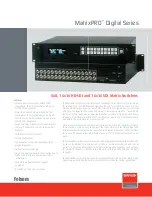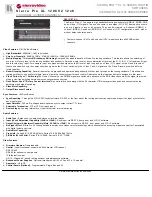
2-27
Catalyst 3750-X and 3560-X Switch Hardware Installation Guide
OL-19593-03
Chapter 2 Switch Installation
Connecting Devices to the Ethernet Ports
10/100/1000 Ethernet Port Connections
The 10/100/1000 Ethernet ports use RJ-45 connectors with Ethernet pinouts. The maximum cable length
is 328 feet (100 meters). The 100BASE-TX and 1000BASE-T traffic requires Category 5, Category 5e,
or Category 6 UTP cable. The 10BASE-T traffic can use Category 3 or Category 4 cable.
The autonegotiation feature is enabled by default on the switch. At this setting, the switch ports
configure themselves to operate at the speed of attached device. If the attached device does not support
autonegotiation, you can explicitly set the switch port speed and duplex parameters. To maximize
performance, either let the ports autonegotiate both speed and duplex, or set the port speed and duplex
parameters on both ends of the connection.
For simplified cabling, the automatic medium-dependent interface crossover (auto-MDIX) feature is
enabled by default on the switch. With auto-MDIX enabled, the switch detects the required cable type
for copper Ethernet connections and configures the interface accordingly. Therefore, you can use either
a crossover or a straight-through cable for connections to a switch 10/100/1000 Ethernet port regardless
of the type of device on the other end of the connection.
See the switch software configuration guide or the switch command reference on Cisco.com for more
information about enabling or disabling autonegotiation and auto-MDIX.
If auto-MDIX is disabled, use the guidelines in
Table 2-3
to select the correct cable for connecting the
switch 10/100/1000 Ethernet ports to other devices. See the
“Cable and Adapter Specifications” section
on page B-5
for cable-pinout descriptions.
PoE+ and UPOE Port Connections
The 10/100/1000 PoE ports have the same autonegotiation settings and cabling requirements that are
described in the
“10/100/1000 Ethernet Port Connections” section on page 2-27
. These ports can provide
PoE, PoE+, or UPOE inline power as described in the
“PoE+ and UPOE Ports” section on page 1-6
.
See
Table 1-18 on page 1-22
for the power supply modules required to support PoE, PoE+, and UPOE
on 24- and 48-port switches.
To access a PoE planning tool, use the Cisco Power Calculator available on Cisco.com:
http://tools.cisco.com/cpc/launch.jsp
You can use this application to calculate the power supply requirements for a specific PoE configuration.
Enter the number and types of powered devices that you plan to attach to the switch, and the calculator
shows the PoE or PoE+ power required and the system power consumption.
Table 2-3
Recommended Ethernet Cables (When Auto-MDIX is Disabled)
Device
Crossover Cable
1
1.
100BASE-TX and 1000BASE-T traffic requires twisted four-pair, Category 5, Category 5e, or
Category 6 cable. 10BASE-T traffic can use Category 3 or Category 4 cable.
Straight-Through Cable
1
Switch to switch
Yes
No
Switch to hub
Yes
No
Switch to computer or server
No
Yes
Switch to router
No
Yes
Switch to IP phone
No
Yes
















































